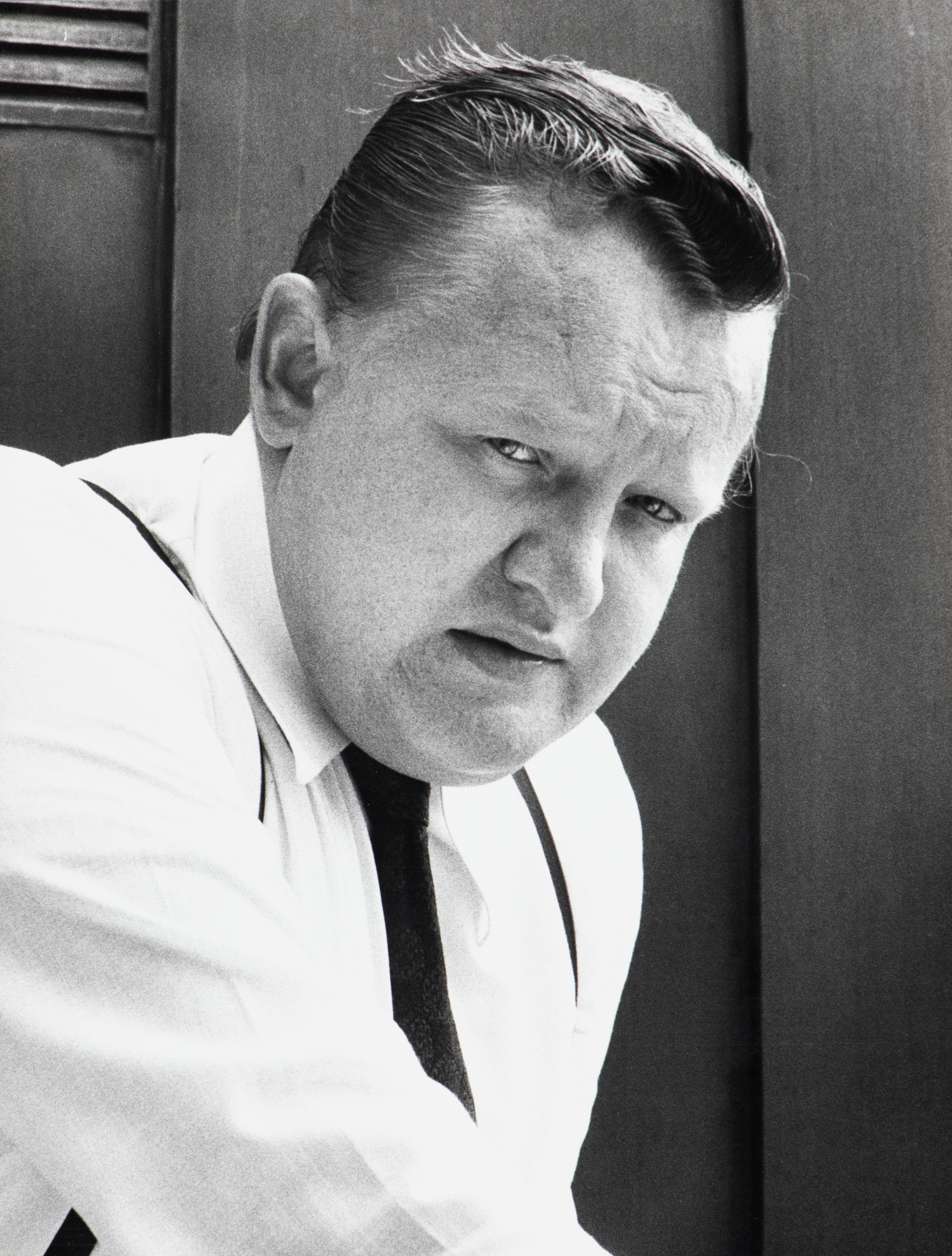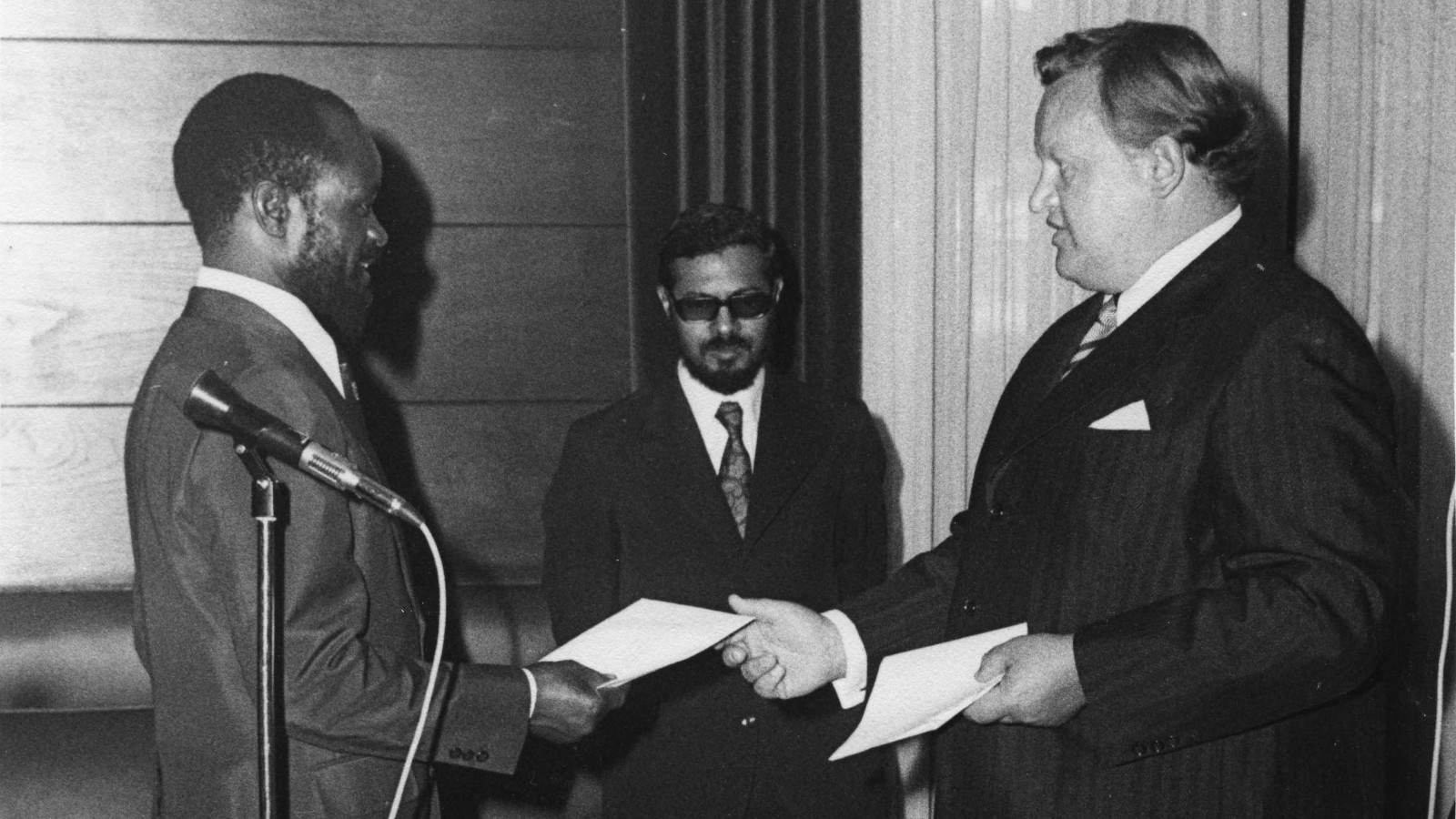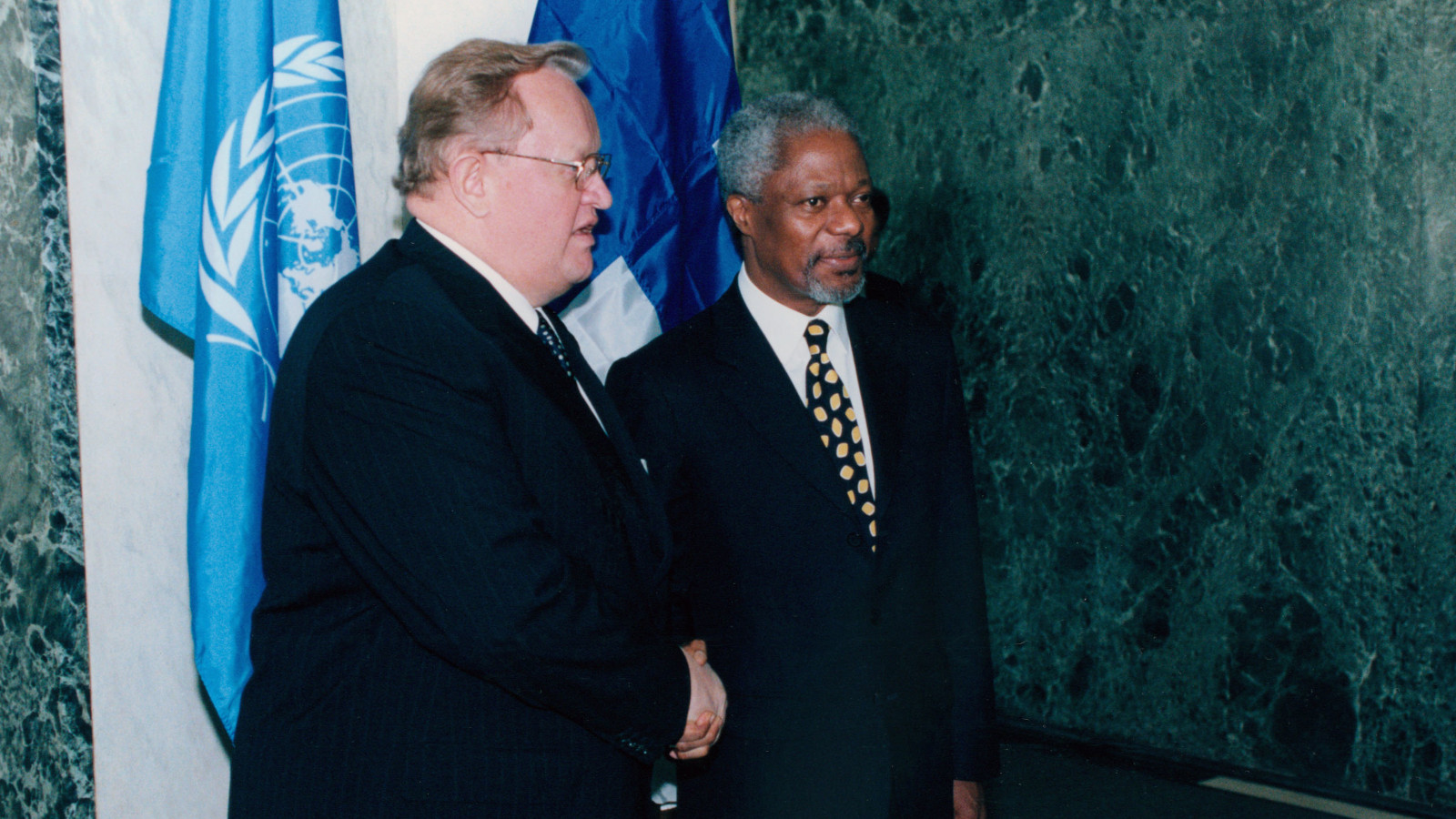Martti Ahtisaari 1937–2023
Former President of the Republic of Finland, Nobel Peace Prize laureate, Ambassador and State Secretary of the Finnish Ministry for Foreign Affairs, Martti Ahtisaari passed away in Helsinki on 16 October 2023 at the age of 86. He was born on 23 June 1937 in Vyborg.
Start of international career

Already at a young age, Ahtisaari, who went to school in Kuopio and Oulu and qualified as a primary school teacher in 1959, had his thoughts on an international career. In autumn 1960, Ahtisaari was appointed manager of a Pakistani boarding school that received development cooperation funds from Sweden. Leaving Oulu for Karachi was a tremendous change for a 23-year-old. The three years Martti Ahtisaari spent in Pakistan were his first contact with the world of development cooperation.
On his return to Finland in autumn 1963, Ahtisaari began studies at the Helsinki School of Economics and Business Administration. He was elected as member of the Student Union’s Foreign Affairs Committee and appointed as board member and executive director of both the Helsinki International Student Club and the Student International Aid Group. It was clear where his interests lay.
Bureau for International Development Aid of the Ministry for Foreign Affairs
Soon, however, Martti Ahtisaari left the world of studies and student life. On 1 April 1965, he was recruited to the Foreign Ministry’s Bureau for International Development Aid, which had been created only two months earlier.
At first, the Bureau operated on a small-scale and it had only three employees. Ahtisaari was responsible for recruiting Finns to UN technical assistance positions and for matters related to Finnish experts in development cooperation projects. A colleague from that time recalls: “Mara radiated warmth with all the strength of his open nature and assembled a group of active people into the Bureau.”
“There was an increased public interest in development aid. At the Bureau, we calculated that the total number of newspaper columns on development aid was 218 metres in the second half of 1965.”
In the latter half of the 1960s, development appropriations grew rapidly, as did the number of staff at the Bureau. The name of the Bureau was changed into the Bureau for International Development Cooperation. Ahtisaari took over the Bureau’s most laborious sector, which dealt with bilateral and Nordic programmes and their appropriations, planning and oversight. His task was also to pursue cooperation with other Nordic countries. He served in different positions, including secretary, section head and division head.
Deputy Director General of the Department for International Development Cooperation
There was a social demand for development cooperation. The Ministry’s development cooperation activities and appropriations continued to grow, leading to the establishment of the Department for International Development Cooperation in April 1972, with Martti Ahtisaari appointed as Deputy Director General. Ahtisaari believed that a department gave better administrative conditions for comprehensive planning of Finland’s development cooperation policy and it helped incorporate development cooperation into Finland’s trade and foreign policy objectives. It also helped achieve those objectives.
Ahtisaari helped Finnish businesses open their eyes to the possibilities of development cooperation. He believed that in political terms development cooperation was important for “strengthening our country’s position in the field of international relations, as a promoter of peaceful solutions and as a demonstration of the unity of Finland and other nations”, according to a memorandum from 1971.
Ambassador in Dar es Salaam
Ahtisaari did not stay long as Deputy Director General. At the fairly young age of 36 years, he was appointed as Ambassador in Dar es Salaam, the United Republic of Tanzania, on 1 August 1973. He was the first Finnish ambassador to have special expertise in development cooperation. In addition to Dar es Salaam, he was also accredited to Zambia (Lusaka), Somalia (Mogadishu) and Mozambique (Maputo).
Finland’s Embassy in Dar es Salaam was originally established to support Finnish development cooperation experts. In his earlier positions, Ahtisaari had visited the country many times. Tanzania was one of Finland’s first development cooperation partners and at the time among the most important ones.
Tanzania was on the brink of gaining an important role in Africa and in the United Nations (UN). An important task of the Embassy was to monitor and report on foreign policy events in Tanzania and its neighbouring countries. Ahtisaari had good contacts with the Tanzanian Foreign Ministry, including the Foreign Minister himself. Finland’s Foreign Ministry noted that the reports from the Embassy were analytical and that they relied on quality sources.

According to a 1976 report on an inspection of the Embassy in Dar es Salaam, the staff considered the Embassy’s “human resources management commendable. The organisational climate was deemed excellent and comfortable and the management method supportive.” The inspector’s conclusion was: “In my opinion, the Embassy in Dar es Salaam is managed skilfully with a long-term approach that uses modern methods.”
Ahtisaari was a sauna enthusiast, and the residence in Dar es Salaam had a sauna built from Finnish logs where Ahtisaari introduced Tanzanian politicians and the city’s foreign diplomats to the wonders of sauna. In February 1974, Ahtisaari invited Finland’s Foreign Minister Ahti Karjalainen and his Tanzanian counterpart to bathe in the residence’s sauna.
Question of Namibia
The United Nations advocated for the independence of Namibia and created the UN Council for Namibia and the office of the UN Commissioner for Namibia. In Dar es Salaam, Ahtisaari had followed closely Namibia’s struggle for independence from South Africa and he had met with representatives of Namibia’s independence movement, the South West Africa People’s Organisation (SWAPO). The UN General Assembly appointed Ahtisaari as UN Commissioner for Namibia in January 1977. His appointment was facilitated by the strong support he received from African countries. The appointment was a turning point in Ahtisaari’s life: he now embarked on an international career.
Ahtisaari and his family had enjoyed their life in Dar es Salaam, but now they had to move to New York. In the years that followed, Ahtisaari’s sole task was to help Namibia become ready for its independence.
This role changed when the UN Secretary-General appointed Ahtisaari as his Special Representative to Namibia in July 1978. Now Ahtisaari’s job was to mediate and resolve the differences of opinion between the parties to the Namibia question and guide Namibia to independence through free elections. In the next five years, Ahtisaari worked hard, travelled extensively, held numerous negotiations and was in constant contact with the parties to the dispute and with senior officials in different countries and the UN. Sometimes the negotiations made headway, at other times they took steps backwards. There were major differences of opinion between the parties, and there seemed to be no political ground to solve the dispute. In 1983, the negotiations seemed to have reached an impasse.
Under-Secretary of State
When the Namibia negotiations deadlocked, Martti Ahtisaari returned to Finland. In August 1983, he was appointed as Under-Secretary of State for development cooperation of the Ministry for Foreign Affairs. Ahtisaari was tasked to contribute to the modernisation of the Department for International Development Cooperation and to coordinate in the Government matters concerning development cooperation and the North–South issues. Development cooperation appropriations had increased tenfold during Ahtisaari’s absence from Finland, and the department had nearly 120 employees and 170 ongoing projects. Ahtisaari was also responsible for representing Finland in international development cooperation organisations and in regional development banks.
The effectiveness of development cooperation and possible misuse of funds was a hot topic in the Finnish press. Ahtisaari emphasised how important it was that the recipient countries set their own targets and objectives for international aid and that aid had to fit the countries’ own development plans. Finland’s development cooperation had to focus on fields where we had high levels of expertise. The Foreign Ministry’s role was to plan and oversee development cooperation, while civil society organisations and companies were responsible for project implementation.
Ahtisaari was in favour of creating favourable conditions for development cooperation at the Ministry. He stressed the importance of having sufficient human resources and a motivated staff and reminded of the benefits of following closely public debate and research around the theme of development cooperation. Ahtisaari estimated that being an Under-Secretary of State gave him “a chance to work with one of the greatest problems of our times together with fascinating and energetic people.”
It was typical of Ahtisaari to stress the importance of cooperation to solve major challenges.
UN Under-Secretary-General for Administration and Management
As Under-Secretary of State in Helsinki, Ahtisaari kept a close eye on the developments in the Namibia process and stayed in contact with UN officials. In spring 1986, he made a number visits to Africa, prompted by the question of Namibia. At the beginning of 1987, Ahtisaari was appointed as UN Under-Secretary-General for Administration and Management. It meant a return to New York. Ahtisaari’s appointment to a top UN position attracted a lot of attention in Finland.
Ahtisaari worked to reform an overly complicated organisation that had excessive bureaucracy and that was facing growing criticism of being inefficient. He understood well the criticism: large organisations tend to run idle to some extent and if they do not think to examine their activities themselves, their financiers will do it for them.
In New York, Ahtisaari was involved in the Namibia talks as the UN Secretary-General’s Special Representative. He was later appointed to oversee the UN operation (UNTAG) in Namibia, which finalised Namibia’s independence in March 1990. After a year in Namibia, Ahtisaari returned to his UN post in New York. In 1992, Namibia granted Martti and Eeva Ahtisaari honorary citizenship. To this day, the UNTAG is considered one of the most successful UN operations.
State Secretary of the Ministry for Foreign Affairs
The position of State Secretary, the highest permanent position at the Ministry for Foreign Affairs, was becoming vacant in Finland, and Ahtisaari was one of the candidates for the post. At the Ministry, however, the choice was not obvious at first and they considered appointing a more distinguished and senior official or someone with expertise in trading policy. In the end, Ahtisaari’s earlier positions in the Foreign Service and his achievements as a UN diplomat tipped the scales in his favour and he was appointed State Secretary on 1 July 1997.
The new State Secretary came face to face with a major upheaval in Europe. The Soviet Union was on the brink of collapse, Yugoslavia was disintegrating and the Baltic States were in the process of gaining independence. Germany was reunified, and Finland was debating whether to join the European Community. In an interview for the Foreign Ministry’s staff newsletter, Ahtisaari estimated that Finland had coped well in all the turbulence. The Ministry had been proactive and professional. However, Finland’s economic recession was also reflected in the Ministry. The amount of work kept growing, but resources did not follow need.
In the summer of 1992, Ahtisaari was asked to chair the UN Working Group for Bosnia and Herzegovina in Geneva, created as a response to the Yugoslav Wars. Later, in autumn 1993, Ahtisaari was granted leave of absence from the Ministry so that he could devote more of his time on the chairmanship.

President of the Republic of Finland
Ever since Ahtisaari returned to Finland from the UN in 1991, the Finnish media had been speculating about his potential presidential candidacy. He was particularly well known for his achievements in Namibia. Ahtisaari was high on opinion polls in 1992, and he announced his candidacy for president in March 1993. A year later, on 1 March 1994, he became the first Finnish president elected by direct popular vote. The Foreign Ministry’s staff newsletter was glad of the result: “I got to choose my candidate without the pomposity of presidential electors. The President was elected from our flock. Mara won. Congratulations!”
Ahtisaari kept his campaign promise to keep in touch with the Finnish people by regularly visiting different regions. He also made more state visits than his predecessors did. For example, he was the first Finnish head of state to visit sub-Saharan Africa when he visited Tanzania and South Africa in 1997. The most significant event of President Ahtisaari’s term of office was Finland’s accession to the European Union in 1995.
Later, in May–June 1999, President Ahtisaari facilitated the agreement for peace in Kosovo. Ahtisaari gained international recognition thanks to the success of the peace negotiations.
Peace broker
Martti Ahtisaari did not seek a second term as President, despite the popularity he had gained from the publicity of his efforts in Kosovo. Instead, he turned his focus on conflict prevention and peace mediation.
In 2000, Ahtisaari founded the Crisis Management Imitative (CMI), a non-governmental organisation dedicated to the prevention and resolution of international conflicts. In the following years, Ahtisaari, supported by the CMI staff, contributed to the resolution of many international conflicts.
Soon after his term as President ended, Ahtisaari led the inspections of secret arms dumps of the Irish Republican Army (IRA) in Northern Ireland. The negotiations between Indonesia and the rebels from the Aceh province reached a conclusion in August 2005 with the signing of a peace agreement. Peace talks in Kosovo continued in the same year, eventually leading to Kosovo’s independence. The list of Ahtisaari’s achievements also include Iraq, the Horn of Africa and Central Asia. In October 2008, the Norwegian Nobel Committee awarded Ahtisaari the Peace Prize for his achievements as peace broker.
Martti Ahtisaari had a long career in the Finnish Foreign Service. During his career in the UN and his term as President and after his presidential term, Ahtisaari amassed an international team to assist him in peace negotiations. He never lost touch with the Foreign Ministry, and often his team of negotiators included officials from the Ministry.
In August 2009, the City of Helsinki designated an 18th century courtyard at the Ministry for Foreign Affairs as Martti Ahtisaari Square. The Foreign Ministry has been a long-term partner of the annual Ahtisaari Days event, which has been organised since 2011. The idea is to transfer international competence in conflict resolution to the national level and to the world of Finnish young people and schools.
"All conflicts can be resolved."
